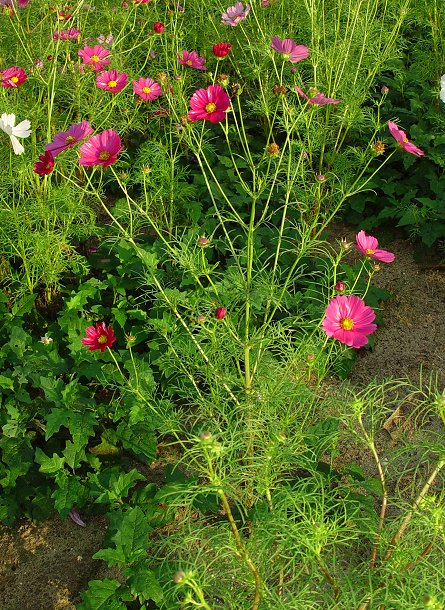Cosmos bipinnatus Cav.
Garden Cosmos

Introduced
CC = *
CW = 3
MOC = 4
© DETenaglia
Cosmos bipinnatus Cav.Garden Cosmos | |
 |
Introduced CC = * CW = 3 MOC = 4 |
© DETenaglia |
|
Family - Asteraceae/Heliantheae Habit - Taprooted annual forb. Stems - Ascending to erect, to 2.0 m, glabrous or sparsely pubescent with short, appressed-ascending hairs, rarely minutely roughened to the touch.
Leaves - Opposite, compound, sessile or with petiole to 1 cm. Blades 1-12 cm long, 1 or 2 times deeply pinnately divided, the ultimate segments narrowly linear, often threadlike, 0.5-1.5 mm wide. Inflorescence - Solitary terminal heads or loose, open clusters, the heads with long, bractless stalks.
Heads - Radiate. Involucre cup-shaped, 6-15 mm long, 7-15 mm in diameter, with bracts in two dissimilar series. Outer series 6-13 mm long, spreading to loosely ascending, linear to narrowly triangular or narrowly lanceolate, tapered to a sharply pointed tip, mostly with slender, white margins. Inner series 7-13 mm long, erect or strongly ascending, lanceolate to narrowly ovate, rounded or more commonly angled to a bluntly or sharply pointed tip, mostly with relatively broad, white margins. Receptacle flat, with chaffy bracts subtending the ray and disc florets, these narrowly oblong to narrowly oblong-lanceolate, somewhat concave, sometimes wrapped around the florets toward the base.
Flowers - Ray florets sterile, the corolla 1.5-4.0 cm long, most commonly pink, less commonly white or purplish pink. Disc florets perfect, the corollas 5-7 mm long, yellow. Pappus of the disc florets of 2-4 short awns, these with downward-angled barbs, rarely very short or absent, when present then mostly persistent and somewhat spreading at fruiting.
Fruits - Achenes 7-16 mm long (including the beak), the surface glabrous but often dotted with scattered impressed glands, smooth or appearing minutely pebbled. Flowering - July - October. Habitat - Railroads, roadsides, open disturbed areas. Commonly cultivated in gardens and sown along roadsides. Origin - Native to Mexico and the southwestern U.S. Lookalikes - From a distance, Oenothera speciosa. Other info. - This striking species can be found escaped in a few counties of Missouri. Most commonly it is encountered as an escape or remnant of past cultivation. The ray flowers are normally pink, but range in color from white to deep purple. Photographs taken off Highway 70 near Kingston, NC., 9-29-02 (DETenaglia); also along Hwy 100 near Washington, Franklin County, MO, 10-10-2009 (SRTurner). |